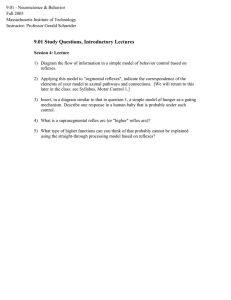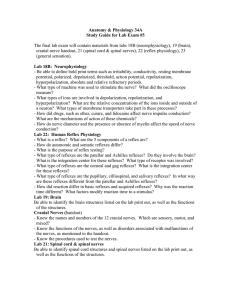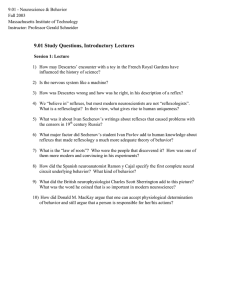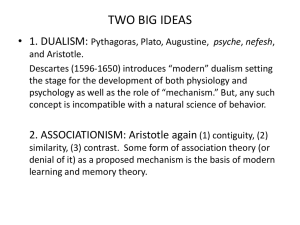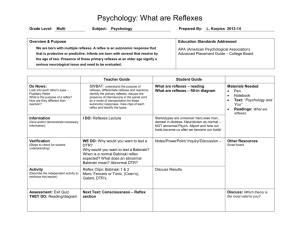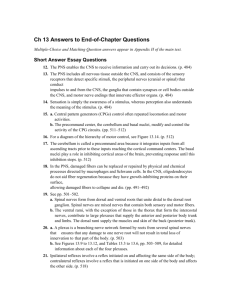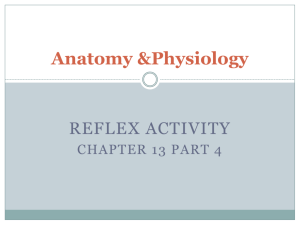Lab Exam 2 Study Guide
advertisement
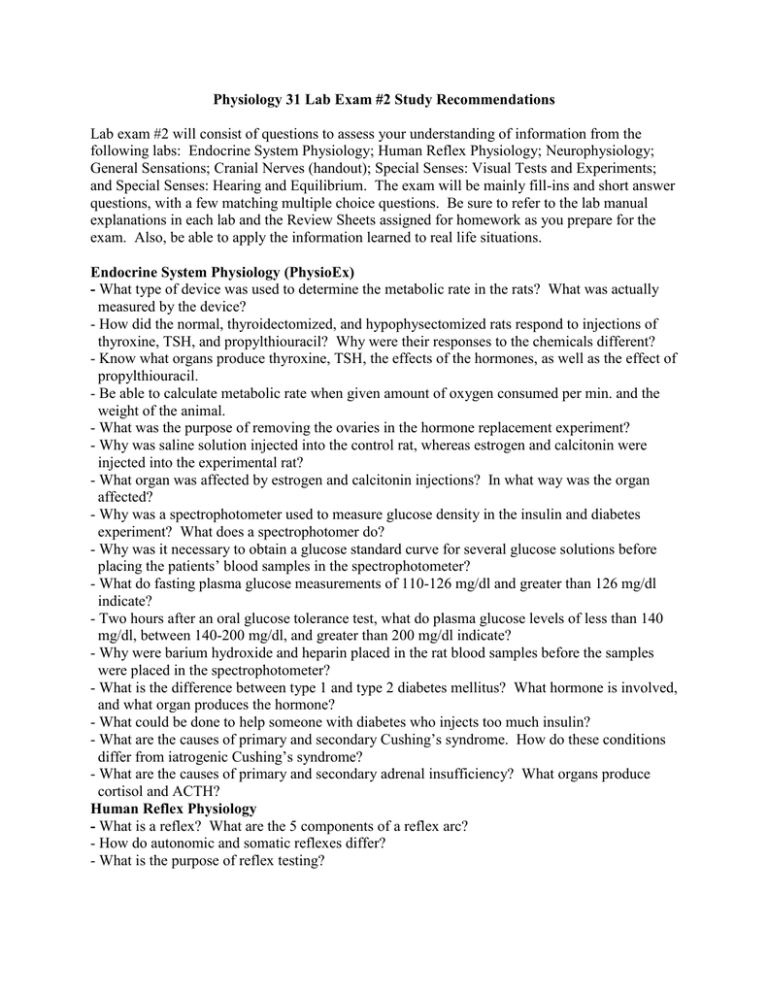
Physiology 31 Lab Exam #2 Study Recommendations Lab exam #2 will consist of questions to assess your understanding of information from the following labs: Endocrine System Physiology; Human Reflex Physiology; Neurophysiology; General Sensations; Cranial Nerves (handout); Special Senses: Visual Tests and Experiments; and Special Senses: Hearing and Equilibrium. The exam will be mainly fill-ins and short answer questions, with a few matching multiple choice questions. Be sure to refer to the lab manual explanations in each lab and the Review Sheets assigned for homework as you prepare for the exam. Also, be able to apply the information learned to real life situations. Endocrine System Physiology (PhysioEx) - What type of device was used to determine the metabolic rate in the rats? What was actually measured by the device? - How did the normal, thyroidectomized, and hypophysectomized rats respond to injections of thyroxine, TSH, and propylthiouracil? Why were their responses to the chemicals different? - Know what organs produce thyroxine, TSH, the effects of the hormones, as well as the effect of propylthiouracil. - Be able to calculate metabolic rate when given amount of oxygen consumed per min. and the weight of the animal. - What was the purpose of removing the ovaries in the hormone replacement experiment? - Why was saline solution injected into the control rat, whereas estrogen and calcitonin were injected into the experimental rat? - What organ was affected by estrogen and calcitonin injections? In what way was the organ affected? - Why was a spectrophotometer used to measure glucose density in the insulin and diabetes experiment? What does a spectrophotomer do? - Why was it necessary to obtain a glucose standard curve for several glucose solutions before placing the patients’ blood samples in the spectrophotometer? - What do fasting plasma glucose measurements of 110-126 mg/dl and greater than 126 mg/dl indicate? - Two hours after an oral glucose tolerance test, what do plasma glucose levels of less than 140 mg/dl, between 140-200 mg/dl, and greater than 200 mg/dl indicate? - Why were barium hydroxide and heparin placed in the rat blood samples before the samples were placed in the spectrophotometer? - What is the difference between type 1 and type 2 diabetes mellitus? What hormone is involved, and what organ produces the hormone? - What could be done to help someone with diabetes who injects too much insulin? - What are the causes of primary and secondary Cushing’s syndrome. How do these conditions differ from iatrogenic Cushing’s syndrome? - What are the causes of primary and secondary adrenal insufficiency? What organs produce cortisol and ACTH? Human Reflex Physiology - What is a reflex? What are the 5 components of a reflex arc? - How do autonomic and somatic reflexes differ? - What is the purpose of reflex testing? - What type of reflexes are the patellar and Achilles reflexes? Do they involve the brain? What is the integration center for these reflexes? What type of receptor was involved? - What type of reflexes are the corneal and gag reflexes? What is the integration center for these reflexes? - What type of reflexes are the pupillary, cilliospinal, and salivary reflexes? In what way are these reflexes different from the patellar and Achilles reflexes? - How did reactions differ in basic reflexes and acquired reflexes? Why was the reaction time different? What factors modify reaction time to a stimulus? General Sensations - What different types of sensory receptors were stimulated in these experiments? What are interoceptors? What are exteroceptors? - In the two-point discrimination test, why were you able to discern two points in some body areas tested, but only one point in other areas? Likewise, why were you able to come closer to a spot touched in some areas in the tactile localization tests? - Which types of receptors demonstrated adaptation (phasic receptors)? How do tonic receptors differ from phasic receptors? Give examples of each. - What is meant by referred pain? What is its physiological basis? Neurophysiology (PhysioEx) - Be able to define bold print terms such as irritability, conductivity, resting membrane potential, polarized, threshold, depolarization, graded potential, action potential, repolarization, hyperpolarization, absolute and relative refractory periods. - What type of device was used to stimulate the nerve? What did the oscilloscope measure? - What types of ions are involved in the resting membrane potential, depolarization, repolarization, hyperpolarization, and the exocytosis of neurotransmitter? What are the relative concentrations of the ions inside and outside of a neuron? What types of plasma membrane transporters take part in these processes? - Compare and contrast Pacinian corpuscles, olfactory receptors, and free nerve endings in their responses to different stimulus modalities, such as pressure, chemicals, heat, and light. -How did drugs, such as tetrodotoxin (TTX) and lidocaine, affect nerve impulse conduction? What are the mechanisms of action of these chemicals? - How is stimulus intensity transmitted by neurons? - How do nerve diameter and the presence or absence of myelin affect the speed of nerve impulse conduction? Cranial Nerves (handout) - Know the names and numbers of the 12 cranial nerves. Which are sensory, motor, and mixed? - Explain the functions of each nerve, as well as disorders associated with malfunctions of the nerves, as mentioned in the handout. - Describe the procedures used to test the nerves. Special Senses: Visual Tests and Experiments - Be able to define bold print terms, such as cataracts, glaucoma, accommodation, emmetropic eye, hyperopia, myopia, astigmatism, binocular vision, convergence, accommodation, and presbyopia. - In the activity demonstrating the blind spot, why did the X disappear as the paper was moved closer to the eye? - What are the two types of photoreceptors found in the retina? What type of vision does each provide? Where is each type of photoreceptor located in the retina? - What is visual acuity and how is it tested? What do numbers such as 20/20, 20/40, etc. mean? - How are the photopupillary, accommodation papillary, and convergence reflexes tested? Of what value are these reflexes? - What instrument is used to view the retina? - Be able to identify eye structures under the microscope. Special Senses: Hearing & Equilibrium - What instrument is used to examine the ear? - How would you test for conductive and sensorineural deafness (i.e., Weber test)? How would you test for bone and air conduction hearing (i.e., Rhine test)? Be able to interpret these tests. - What ear structures are involved in hearing? Describe the how the ear structures allow for hearing. Be able to the identify inner ear structures under the microscope. - What two ear regions are involved in the sense of equilibrium and balance? How does each region contribute to the maintenance of equilibrium and balance? - What types of tests were done to illustrate the equilibrium apparatus functions? - What is the Romberg test, and what does it test for? - Be able to define terms such as nystagmus, vertigo, and presbycussis.
